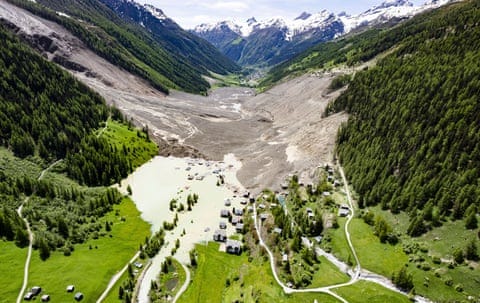I’m back from a week of cycling in Barcelonnette, a wonderful town in the Alpes-de-Haute-Provence in eastern France that happens to be a perfect staging ground for two-wheeled adventures. Every day provided unbelievable vistas of ravines, mountain peaks, and rivers, with one consistent factor being the temperatures, which were between 32 and 34 degrees by late morning. Sure, we have the same temps in sea-level Toronto right now, but Barcelonnette is at 1100m, and the rides go up to 2800m from there. So suffice it to say, air conditioning historically hasn’t even been on the radar!
Also consistent in this area of the Alps was the lack of glaciers, unlike those I enjoyed a bit further north in 2022 and 2023, where some remnants still exist. If you need a visual on how warming can catastrophically impact a region, then the images from the recent Birch glacier collapse in Switzerland are a pretty good place to start.
Western Europe has lost around 50% of its alpine glacial volume since 1950, with most occurring since 1980, and recent trends are not encouraging. Some of the high Austrian Alps were snow-free already by May, and as Andrea Fischer at the Institute of Interdisciplinary Mountain Research of the Austrian Academy of Sciences noted:
“Parts have been snow-free entirely, which was never the case since the measurements began.”
This effectively lengthens the melting season, with every additional day of exposure resulting in the disappearance of 10 centimeters of ice. Once the glacier is gone, it’s just rainfall and seasonal snowpack left to feed those wonderful rivers I rode along, making for short seasons of decent hydrology.
Other than an actual collapse, such as in Switzerland, most glaciers die gradually and are thereby generally ignored by markets despite a myriad of ecological and human impacts. Even the burial of the Swiss town of Blatten did nothing to stir market spirits.
That’s not to say we can’t price the impacts of warming - after all, a town and its surrounding ecosystem and economy are worth something. Bloomberg Intelligence, for instance, had a turn at providing an estimate of the recent economic costs of weather events to the US economy, and it’s decidedly not pretty:
“The US has spent nearly $1 trillion on disaster recovery and climate-related needs over the 12 months ending May 1, equivalent to 3% of GDP.”
But as I’ve been highlighting here and in speaking engagements, you won’t see this reflected in share prices; rather, it’s coming through in insurance premiums, repair spending, and federal aid (not to mention higher power prices). In other words, consumers are feeling it even if it's diffuse—somewhere there is 3% less to spend on other things.
Investors, on the other hand, wouldn’t have even noticed a blip in their US portfolios over this period, especially relative to trade or war issues. In fact, there are likely more companies benefiting (through higher prices, emergency spending, etc.) than seeing a meaningfully negative share price impact.
The distinction couldn’t be more important, yet it is missed by many, even in sustainable finance. So far, portfolio returns remain resilient despite significant warming-related weather events. I’ve realized, often while pedaling away, that predicting this is going to change is akin to prophesizing - it’s what we want to happen vs. what is happening.
Clearly, when you have a theory of change reliant on shocks to asset prices to provide evidence that uncontrolled warming matters, not getting them is a bit of a problem. What to do if portfolios simply continue to hum along on AI driven euphoria while our other selves (consumers and taxpayers) quietly pick up the bill?
Imagine the irony of the teacher who retires in 2050 on a full pension after spending years describing climate risks to her students. Or the ‘net zero’ central banker cum growth-driven ‘major projects’ leader here in Canada. Both are well aware of the impacts all around us, but acting as investors, we all benefit from knowing that those impacts are not captured by the capital markets. Sure, one day, maybe…
But then I remember one portfolio manager asking me years ago:
“Martin why would I want to the market to know about a company’s emissions if its not a regulated disclosure? How’s that going to help the share price?”
In other words, investors prefer to make money with the least drama possible. Preaching about ‘possible’ market chaos in the distant future seems oblivious to the temperature of the room, which, as you know, is already pretty toasty. There is no lack of highly visible ecological consequences today of our race to exceed 1.5-degree targets; after all, everyone should be able to relate to declining coral reefs, glaciers, and forests. Those of us in finance would need to find a way of communicating the lifestyle and financial implications to average folks who think an ‘existential’ risk sounds like someone else’s problem yet are unknowingly paying a considerable price.
But I’m not sure investors will actually take the proverbial bull by the horns. We could well turn out to be the most insulated species ever to roam the planet. And, let’s be honest, we kind of like it like that.





This is a great one! 🌇